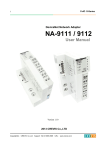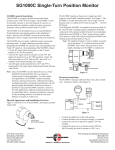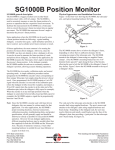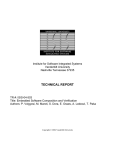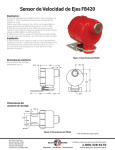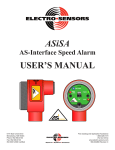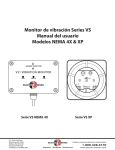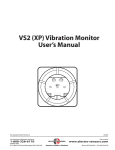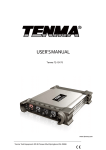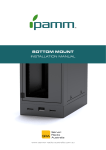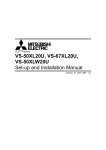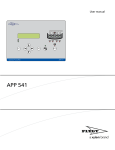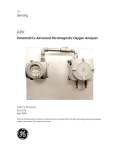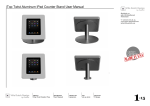Download SpeedTalker DeviceNet XP Operation Manual - Electro
Transcript
SpeedTalker-DN (XP) DeviceNet Shaft Speed Sensor with Alarms USER’S MANUAL 6111 Blue Circle Drive Minnetonka, MN 55343 Phone: 952.930.0100 Fax: 952.930.0130 ISO 9001:2000 Certified Free Catalog and Application Assistance 1.800.328.6170 Visit Us Online www.electro-sensors.com 990-002300 Revision B Organization 1. 2. Overview Operation 3. Setup 4. 2.1 2.2 2.3 Indicator LEDs Speed measurement Alarm Functions 3 3 4 3.1 3.2 3.3 3.4 3.5 3.6 Mechanical installation Wiring, power-up, getting on-line Set MAC ID, Baud Rate Configure parameters Configure scanner Interpreting I/O data 5 6 6 6 7 7 4.1 Object model 4.1.1 Objects present 4.1.2 Object interfaces 4.1.3 Objects that affect behavior 4.1.4 Object instance attributes Identity Object Message Router Object DeviceNet Object Assembly Object Explicit Messaging Connection Object Poll I/O Connection Object COS I/O Connection Object Speed (application) Object Alarm (application) Object I/O Data Format 4.2.1 I/O Assembly instances 4.2.2 Format of I/O Assembly data 4.2.3 I/O Assembly data attribute mapping Device Configuration 4.3.1 Config. param. listing (EDS), effect on behavior 4.3.2 Configuration parameter mapping (EDS) 4.3.3 Configuration parameter groups (EDS) Device Profile 4.2 4.3 5. page Specifications 8 8 9 9 9 9 9 10 10 11 11 12 13 13 13 14 14 15 16 2 1. Overview The SpeedTalker-DN (XP) continuously monitors rotating shaft speed, providing measured RPM and the status of up to four alarm functions over DeviceNet. Measurable speed ranges from 0.0 to 6,553.5 RPM. Each configurable alarm function has on/off, overspeed/underspeed, speed threshold, delay time and minimum on-time settings. All configuration is handled over DeviceNet with parameter settings stored in non-volatile memory. An electronic data sheet file (EDS) is provided to aid configuration. Speed measurement and alarm status are provided over the Poll I/O connection. Alarm status is also provided over the COS I/O connection for applications requiring sensor-initiated underspeed and/or overspeed notification (e.g. ‘zero-speed’ sensing). 2. Operation 2.1 Indicator LEDs The Network Status and Module Status indicators are located inside the enclosure (remove round cover to view them). They are provided to aid setup, diagnostics and troubleshooting. Their operation is standard DeviceNet. LED state Off Flashing Green Green Flashing Red Red Flashing Red/Green Network Status (NS) Not powered / not on-line On-line, not connected On-line, connected IO connection timed-out Comm fault Module Status (MS) Not powered Device Standby Device Operational Minor Fault Unrecoverable Fault Device Self-Testing 2.2 Speed measurement SpeedTalker-DN (XP) detects alternating magnetic pulses from a shaft-mounted rotating Pulser Disk or Pulser Wrap and converts the pulse frequency into measured speed (RPM) units. The RPM value is given in the Measured Speed attribute of the Speed object and is also part of the Assembly object’s Data attribute (Poll I/O connection). See the Device Profile for details. The Measured Speed is governed by two configuration parameters: Target Pulses/Rev (PPR) Set this to the pulses per revolution of the Pulser Disk/Wrap used. Note that the Target PPR is one-half the number of Pulser Disk/Wrap magnets. Minimum measurable speed Sets the minimum shaft speed (RPM) below which the measured RPM will be zero. This is particularly useful in slower speed applications to reduce the time taken to detect zero RPM. 3 2.3 Alarm functions Four configurable alarm functions (Alarm 4...1) are provided for detecting underspeed or overspeed conditions. Each may be used individually or in any combination with the others. All have identical capabilities and each works independently of the others. The states (Alarmed/Not-Alarmed) of the four alarm functions are given in the low four bits of the Alarm Status attribute of the Alarm object and is part of the Assembly object’s Data attribute (Poll I/O connection). Alarm Status is also available over the COS I/O connection for applications requiring sensor-initiated underspeed and/or overspeed notification. See the Device Profile for details. The following three configuration parameters apply to all four alarm functions: Alarm 4...1 ON/OFF The low four bits of this parameter selectively turn the alarm functions ON/OFF. Alarm 4...1 Over/Under The low four bits of this parameter set alarm overspeed/underspeed functionality for the alarm functions. When set for overspeed, a function becomes alarmed when measured speed is greater than the Overspeed Alarmed trip-point and becomes not-alarmed when it is less than the Not-Alarmed trip-point. When set for underspeed, a function becomes alarmed when measured speed is less than the Underspeed Alarmed trip-point and becomes not-alarmed when it is greater than the Not-Alarmed trip-point. Alarm threshold hysteresis Works with each function’s Alarm Threshold and Over/Under setting to determine the RPM trip-point for exiting the Alarmed state. It has no effect on the RPM trip-point for entering the Alarmed state. Over/Underspeed Alarmed trip-point: Alarm Threshold Overspeed Not-Alarmed trip-point: (1 - %Hysteresis/100) * Alarm Threshold Underspeed Not-Alarmed trip-point: (1 + %Hysteresis/100) * Alarm Threshold Example for %Hysteresis = 1%, Alarm Threshold = 100.0 RPM, Overspeed: Alarmed trip-point = 100 RPM, Not-Alarmed trip-point = 99.0 RPM Each alarm function has the following configuration parameters: Alarm threshold Sets the RPM trip-point for entering the Alarmed state. Also works with the Alarm threshold hysteresis and the function’s Over/Under setting to determine the RPM trip-point for exiting the Alarmed state. Over/Underspeed Alarmed trip-point: Alarm Threshold Overspeed Not-Alarmed trip-point: (1 - %Hysteresis/100) * Alarm Threshold Underspeed Not-Alarmed trip-point: (1 + %Hysteresis/100) * Alarm Threshold Alarm ON delay Sets the time that measured speed must be continuously at alarm levels before the function enters the Alarmed state. This setting is useful for avoiding nuisance alarms resulting from transient speed excursions into alarm levels. Alarm ON minimum time Sets the minimum time a function stays Alarmed once it has entered the Alarmed state. 4 3. Setup 3.1 Mechanical installation The SpeedTalker-DN (XP) may be mounted on rigid conduit or with the mounting bracket assembly (provided). The gap (A) between the sensing head and the Pulser Disk/Wrap must be 1/16 to 1/4 inch. The center line of the magnets (B) must allign with the center of the sensing head as the Pulser Disk/ Wrap rotates. After mounting, remove the round cover and pull network cable through the conduit port into the enclosure. B A With Pulser Disk Target � A A With Pulser Wrap Target 5 3.2 1. Wiring, power-up and getting on-line After mounting and pulling DeviceNet cable into the enclosure, remove the connector plug from its socket and connect the color-coded DeviceNet cable wires to the corresponding connector plug terminals. ����������� ���������� ������ ������������ �������� MS ������������� �������������� NS 2. 3. 4. 3.3 1. 2. 3.4 1. 2. 3. Connector terminals and Indicator LEDs Re-install the connector plug. If the network is powered, the LEDs will sequence through a brief test: Network Status OFF, Module Status GREEN-RED-GREEN, Network Status GREEN-REDOFF. If there are no MAC ID or Baud Rate conflicts on the network, the Network Status LED should then flash GREEN indicating the node is on-line but not connected. Set MAC ID, Baud Rate (DeviceNet Commissioning Tool required) Once on-line, scan the network to find the SpeedTalker-DN (XP). Once found, you may change the MAC ID and/or Baud Rate. The factory defaults are MAC ID 63 and Baud Rate 125k. MAC ID changes take effect immediately, initiating a reset sequence similar to that of power-on. Baud Rate changes don’t take effect until SpeedTalker-DN (XP) power is cycled off/on. Configure SpeedTalker parameters (DeviceNet Configuration Tool required) Register the SpeedTalker-DN (XP) EDS file with your DeviceNet Configuration Tool. Your DeviceNet Configuration Tool uses this file to create a user-friendly interface to the configuration parameters. Speed configuration parameters: 2.1 Target Pulses/Rev (PPR) Enter the PPR for the Pulser Disk/Wrap used. Note: The PPR is one-half the number of Pulser Disk/Wrap magnets. 2.2 Minimum measurable speed Enter the minimum shaft speed (RPM) below which you want the measured RPM to be zero. Speed parameters may be changed in either order. Changes take effect immediately. Alarm configuration parameters: Set the configuration parameters for any/all desired Alarm functions. Alarm parameters may be changed in any order. Changes take effect immediately. 6 3.5 1. 2. Configure Scanner (DeviceNet Configuration Tool required) Add the SpeedTalker to the Scanner’s scanlist: Select the SpeedTalker-DN (XP) from the Scanner’s list of available devices and add it to the scanlist. Select and map the SpeedTalker Inputs: 2.1 Select the desired SpeedTalker-DN (XP) input (Poll or COS) from the Scanner’s list of available inputs. The Poll connection produces the Assembly Object’s data attribute value (Class ID = 4, Instance = 101, Attribute = 3). The COS connection produces the Alarm Object’s Alarm Status attribute value (Class ID = 101, Instance = 1, Attribute = 16). 2.2 Map the selected input to the desired Scanner memory locations. For the Poll connection, set the byte offset and bit length to map the desired Data Component (Speed Value, Alarm Status or both) from the I/O Assembly. See 4.2 I/O Data Format for details. For Speed Value only, set the byte offset to 0 and bit length to 16. For Alarm Status only, set the byte offset to 2 and bit length to 8. For both, set the byte offset to 0 and bit length to 24. 3.6 1. Interpreting I/O data Speed Value Data type: 16-bit unsigned integer (UINT) User-units: RPM Resolution: 0.1 RPM Minimum value (0x0000) represents 0.0 RPM Maximum value (0xFFFF) represents 6,553.5 RPM. Source: Speed Object’s Measured Speed attribute (class/inst./attr. 100/1/3) 2. Alarm Status Data type: 8-bit boolean (BYTE) Bit assignment: Bit 0 Alarm 1 status Bit 1 Alarm 2 status Bit 2 Alarm 3 status Bit 3 Alarm 4 status Bit 4 0 (unused) Bit 5 0 (unused) Bit 6 0 (unused) Bit 7 0 (unused) Bit encoding: 0 - Not Alarmed 1 - Alarmed Source: Alarm Object’s Alarm Status attribute (class/inst./attr. 101/1/16) 7 4. Device Profile 4.1 Object model Alarm Object (application) Speed Object (application) Identity Object Assembly Object (input) Message Router DeviceNet Object I/O Connection Class Explicit Message DeviceNet Network 4.1.1 Objects present (generic device profile) 4.1.2 Object Interfaces Object Identity Message Router DeviceNet Assembly Connection Speed (application) Alarm (application) Object Identity Message Router DeviceNet Assembly Connection(s) Speed (application) Alarm (application) Class ID code 1 2 3 4 5 100 101 Optional/required Required Required Required Required Required [> 1 app. obj. req’d] [> 1 app. obj. req’d] # Instances 1 1 1 1 3 (Exp Mes, Poll I/O, COS I/O) 1 1 Interface Message Router Explicit Messaging Connection Instance Message Router Poll I/O Connection or Message Router Message Router Assembly or Message Router COS I/O Connection, Assembly or Message Router 8 4.1.3 Objects that affect behavior Object Identity Message Router DeviceNet Assembly Connection Speed (application) Effect on behavior Supports the Reset service No effect Configures port attributes (baud, MAC ID, BOI proc.) Defines I/O data format Contains the number of logical ports into or out of device Configures pulser-disk ppr, minimum measurable speed Configures speed thresholds, time delays, min. ON times, over/under functionality, ON/OFF and hysteresis for Alarm 4... Alarm 1 functions Alarm (application) 4.1.4 Object instance attributes (by Class, Instance) Identity Object (Class ID = 1, Instance = 1) Attrib. ID 1 2 3 Access Rule Get Get Get 4 Get 5 6 7 8 Get Get Get Get Name Vendor ID Device Type Product Code Revision Major rev. Minor rev. Status Serial Number Product Name State Data Type UINT UINT UINT STRUCT of USINT USINT WORD UDINT SHORT- STRING USINT Value 804 0 (generic profile) 1 ----[realtime code] [unique code] “SpeedTalker-DN (XP)” 0-5 (like MS) Message Router Object (Class ID = 2, Instance = 1) No externally visible interface to this object instance. DeviceNet Object (Class ID = 3, Instance = 1) Attrib ID 1 2 3 4 Access Rule Get/Set Get/Set Get/Set Get/Set 5 Get Name MAC ID Baud Rate BOI Bus-Off Counter Allocation Info Allocation Choice Master’s MAC ID Assembly Object (Class ID = 4, Instance = 101) Data Type USINT USINT BOOL USINT STRUCT of: BYTE USINT Attrib ID Access Rule Name Data Type 3 Get Data Array of bytes: Value 63 (fac. def.) 0 (fac. def. 125k) 0 (fac. def. OFF) 0 (reset val) [alloc byte] [master MAC ID dependent] Value Speed (low) Speed (high) Alarm4...1 9 Explicit Messaging Connection Object (Class ID = 5, Instance = 1) Attribute ID 1 2 3 4 5 6 7 8 9 12 13 14 15 16 17 Access Rule Get Get Get Get Get Get Get Get Get/Set Get Get Get Get Get Get Name State instance_type transportClass_trigger produced_connection_id consumed_connection_id initial_comm_characteristics produced_connection_size consumed_connection_size expected_packet_rate watchdog_timeout_action produced_conn_path_length produced_connection_path consumed_conn_path_length consumed_connection_path production_inhibit_time Data Type USINT USINT BYTE UINT UINT BYTE UINT UINT UINT USINT UINT EPATH UINT EPATH UINT Poll I/O Connection Object (Class ID = 5, Instance = 2) Attribute Access Data Name ID Rule Type 1 Get State USINT 2 Get instance_type USINT 3 Get transportClass_trigger BYTE 4 Get produced_connection_id UINT 5 Get consumed_connection_id UINT 6 Get initial_comm_characteristics BYTE 7 Get produced_connection_size UINT 8 Get consumed_connection_size UINT 9 Get/Set expected_packet_rate UINT 12 Get watchdog_timeout_action USINT 13 Get produced_conn_path_length UINT 14 Get produced_connection_path EPATH 15 Get consumed_conn_path_length UINT 16 Get consumed_connection_path EPATH 17 Get/Set production_inhibit_time UINT Value 0x00 (reset) 0x00 (explicit) 0x83 [slave MAC ID dependent] [slave MAC ID dependent] 0x21 (prod grp 2, cons grp 2) 37 37 2500 (default in mS) 1 (default - auto delete) 0 (default) Empty 0 (default) Empty 0 (mS) Value 0x00 (reset) 0x01 (I/O) 0x83 [slave MAC ID dependent] [slave MAC ID dependent] 0x01 (prod grp 1, cons grp 2) 3 0 [must be set] 0 (default - Timed Out state) 6 “20 04 24 65 30 03” 6 “20 64 24 01 30 04” 0 (mS) 10 COS I/O Connection Object (Class ID = 5, Instance = 4) Attribute ID 1 2 3 4 5 6 7 8 9 12 13 14 15 16 17 Access Rule Get Get Get Get Get Get Get Get Get/Set Get Get Get Get Get Get/Set Name State instance_type transportClass_trigger produced_connection_id consumed_connection_id initial_comm_characteristics produced_connection_size consumed_connection_size expected_packet_rate watchdog_timeout_action produced_conn_path_length produced_connection_path consumed_conn_path_length consumed_connection_path production_inhibit_time Data Type USINT USINT BYTE UINT UINT BYTE UINT UINT UINT USINT UINT EPATH UINT EPATH UINT Value 0x00 (reset) 0x01 (I/O) 0x12 or 0x10 [per ack setting] [slave MAC ID dependent] [slave MAC ID dependent] 0x01 or 0x0F [per ack setting] 1 0 [must be set] 0 (default - Timed Out state) 6 “20 65 24 01 30 10” 6 “20 64 24 01 30 04” 0 (mS) Speed (application) Object (Class ID = 100, Instance = 1) Attribute ID 1 2 3 Access Rule Get/Set Get/Set Get Name PPR Minimum Speed Measured Speed Data Type UINT UINT UINT Value 8 (fac. def), range: 1 -> 256 10 (fac. def.), range: 1 -> 65535 [measured RPM] 11 Alarm (application) Object (Class ID = 101, Instance = 1) Attribute ID 1 2 3 4 5 6 7 8 9 10 11 12 13 14 Access Rule Get/Set Get/Set Get/Set Get/Set Get/Set Get/Set Get/Set Get/Set Get/Set Get/Set Get/Set Get/Set Get/Set Name Alarm 1 Threshold Alarm 1 On Delay Time Alarm 1 On Minimum Time Alarm 2 Threshold Alarm 2 On Delay Time Alarm 2 On Minimum Time Alarm 3 Threshold Alarm 3 On Delay Time Alarm 3 On Minimum Time Alarm 4 Threshold Alarm 4 On Delay Time Alarm 4 On Minimum Time Threshold % Hysteresis Alarm 4...1 Overspeed/Underspeed Get/Set Select Data Type UINT USINT USINT UINT USINT USINT UINT USINT USINT UINT USINT USINT USINT BYTE 15 Get/Set Alarm 4...1 On/Off Settings BYTE 16 Get Alarm (4...1) Status BYTE Value 10 (fac. def), range 1 -> 65535 0 (fac. def), range 0 -> 250 0 (fac. def), range 0 -> 250 10 (fac. def), range 1 -> 65535 0 (fac. def), range 0 -> 250 0 (fac. def), range 0 -> 250 10 (fac. def), range 1 -> 65535 0 (fac. def), range 0 -> 250 0 (fac. def), range 0 -> 250 10 (fac. def), range 1 -> 65535 0 (fac. def), range 0 -> 250 0 (fac. def), range 0 -> 250 10 (fac. def), range 0 -> 250 0x00 (fac. def), bit encoding: 1 OVER, 0 UNDER 0x00 (fac. def), bit encoding: 1 ON, 0 OFF bit encoding: 1 ALARMED, 0 NOT ALARMED Application Object (Speed, Alarm) attribute user units: Speed settings/measurements are in RPM. Time settings are in seconds. Hysteresis settings are in %. Application Object (Speed, Alarm) attribute encoding: User-units resolution for all integer type (UINT, USINT) attributes (except PPR) is 0.1 (e.g. integer change of 1 equals 0.1 change in RPM, seconds or %). User-units resolution for PPR attribute is 1 (integer change of 1 equals PPR change of 1). Bit assignment for BYTE type attributes Bit 7 -- Bit 6 -- Bit 5 -- Bit 4 -- Bit 3 Alarm 4 Bit 2 Alarm 3 Bit 1 Alarm 2 Bit 0 Alarm 1 12 4.2 I/O Data Format 4.2.1 I/O Assembly Instances Number 1 4.2.2 Byte 0 1 2 Type Input Name Input data Format of I/O Assembly Data Bit 7 Bit 6 Bit 5 0 0 0 Bit 4 Bit 3 Speed Value Low Speed Value High 0 Alarm4 4.2.3 I/O Assembly Data Attribute Mapping Class Data Component Name Number Name Speed Value Alarm Status Notes: Speed Alarm 100 101 Inst. Number 1 1 Bit 2 Bit 1 Bit 0 Alarm3 Alarm2 Alarm1 Attribute Name Number Meas. Speed Status 3 16 Data Type UINT BYTE Speed Value resolution is 0.1 (UINT change of 1 equals 0.1 change in RPM). I/O Assembly Data (class/inst./attr. 4/101/3) is produced by the Poll connection. Alarm Status (class/inst./attr. 101/1/16) is produced by the COS connection. 13 4.3 Device Configuration Configurable parameters and definition of public interface 4.3.1 Configuration parameter listing (EDS) and effect on behavior 4.3.2 Configuration Parameter Mapping (EDS) Number Name 1 Target pulses/rev 2 Minimum meas. speed 3 Measured speed (read-only) 4 Alarm 1 threshold 5 Alarm 1 ON delay 6 Alarm 1 ON min time 7 Alarm 2 threshold 8 Alarm 2 ON delay 9 Alarm 2 ON min time 10 Alarm 3 threshold 11 Alarm 3 ON delay 12 Alarm 3 ON min time 13 Alarm 4 threshold 14 Alarm 4 ON delay 15 Alarm 4 ON min time 16 Alarm threshold hysteresis 17 Alarm 4...1 OVER/UNDER 18 Alarm 4...1 ON/OFF 19 Alarm (4...1) status (read-only) Number Name 1 2 3 4 5 6 7 8 9 10 11 12 13 14 15 16 17 18 19 Target pulses/rev Minimum measurable speed Measured speed (read-only) Alarm 1 threshold Alarm 1 ON delay Alarm 1 ON min time Alarm 2 threshold Alarm 2 ON delay Alarm 2 ON min time Alarm 3 threshold Alarm 3 ON delay Alarm 3 ON min time Alarm 4 threshold Alarm 4 ON delay Alarm 4 ON min time Alarm threshold hysteresis Alarm 4...1 Over/Under Alarm 4...1 ON/OFF Alarm (4...1) status (read-only) Effect on behavior Sets target +/- pulses per revolution for correct RPM reading Sets the actual speed below which the measured speed is 0 [not write-able - no effect on behavior] Sets speed levels for Alarm1 Overspeed/Underspeed functions Time that meas. speed must be at alarm-level for alarmed state Minimum time Alarm 1 stays alarmed Sets speed levels for Alarm2 Overspeed/Underspeed functions Time that meas. speed must be at alarm-level for alarmed state Minimum time Alarm 2 stays alarmed Sets speed levels for Alarm3 Overspeed/Underspeed functions Time that meas. speed must be at alarm-level for alarmed state Minimum time Alarm 3 stays alarmed Sets speed levels for Alarm4 Overspeed/Underspeed functions Time that meas. speed must be at alarm-level for alarmed state Minimum time Alarm 4 stays alarmed Sets hysteresis - applies to all Alarm thresholds bits 3...0 select Alarm 4...1 functions: 1-Overspeed / 0-Under bits 3...0 turn Alarm 4...1 functions on/off: 1-ON / 0-OFF [not write-able - no effect on behavior] Name Speed Speed Speed Alarm Alarm Alarm Alarm Alarm Alarm Alarm Alarm Alarm Alarm Alarm Alarm Alarm Alarm Alarm Alarm Class Number 100 100 100 101 101 101 101 101 101 101 101 101 101 101 101 101 101 101 101 Inst. Number 1 1 1 1 1 1 1 1 1 1 1 1 1 1 1 1 1 1 1 Attrib. Number 1 2 3 1 2 3 4 5 6 7 8 9 10 11 12 13 14 15 16 Data Type UINT UINT UINT UINT USINT USINT UINT USINT USINT UINT USINT USINT UINT USINT USINT USINT BYTE BYTE BYTE 14 4.3.3 Configuration Parameter Groups (EDS) Group Number Group Name 1 Speed Configuration 2 Alarm Configuration 3 Monitor Parameter Number 1 2 3 4 5 6 7 8 9 10 11 12 13 14 15 16 17 18 19 3 19 Parameter Name Target pulses/rev Minimum measurable speed Measured speed (read-only) Alarm 1 threshold Alarm 1 ON delay Alarm 1 ON min time Alarm 2 threshold Alarm 2 ON delay Alarm 2 ON min time Alarm 3 threshold Alarm 3 ON delay Alarm 3 ON min time Alarm 4 threshold Alarm 4 ON delay Alarm 4 ON min time Alarm threshold hysteresis Alarm 4...1 Over/Under Alarm 4...1 ON/OFF Alarm (4...1) status (read-only) Measured speed (read-only) Alarm (4...1) status (read-only) Note: The configuration parameters are defined in the Electronic Data Sheet (EDS) only. The SpeedTalker_DN (XP) does not contain Parameter Objects. 15 5. Specifications Measurable shaft speed range 0.0 to 6,553.5 RPM Pulse frequency range 0.0112 to 31,250 Hz Measurement accuracy (over temp) 0.02% max error (frequency) Measurement/setting resolution 0.1 RPM Pulser Disk/Wrap pulses/revolution 1 to 256 PPR Airgap (sensing head to Disk/Wrap) 1/16 to 1/4 inch (2 to 6 mm) Operating Power (network supplied) 11Vdc (60mA) to 25Vdc (40 mA) DeviceNet implementation Node type Connections Profile Baud rates Indicators Connector Configuration Operating Temperature -40 to 85 °C (-40 to 185 °F) Enclosure hazardous locations ratings Group 2 Only slave Poll, COS, Explicit Message Generic Device 125k, 250k, 500k Module, Network Status Open style Electronic Data Sheet (EDS) Class I, Div 1, Group C, D Class II Groups E, F, G UL File: E249019 Weight (with bracket) 2.45 Lb (1.11 kg) Dimensions (with bracket) (in inches) 0.25 1.84 4.40 1.38 4.81 3.90 4.00 2.38 1" NPT 1.250 0.260 2.750 1.630 0.560 0.316 Specifications are subject to change without notice. 16

















